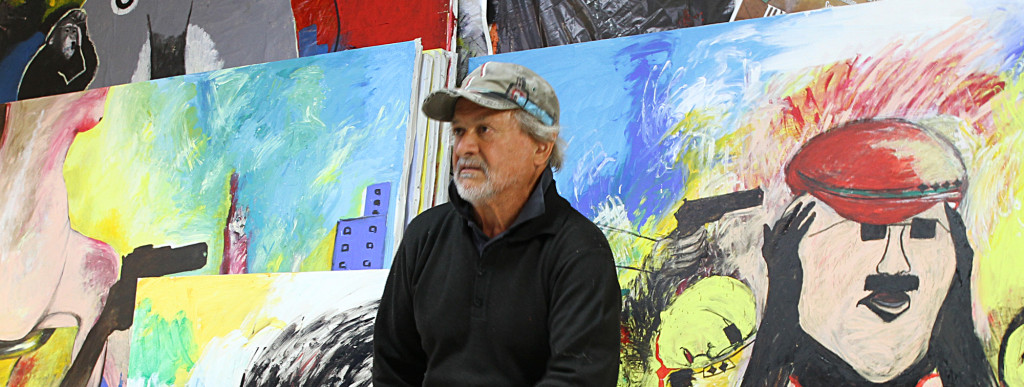
Un artista anarchico Maffeo d’Arcole
Entrare nel suo studio è come lacerare una tela per aprirsi un varco nella sua anima.
Ci si scopre immergersi nel suo mondo, nei pensieri che lo accompagnano quando la sua mano dipinge per dar vita alle opere che popolano lo spazio circostante, in ogni dove.
All’ingresso, in giardino, “L’albero magico”, una rappresentazione molto intensa della morte, un tema cui Maffeo sta lavorando da quando è venuto a mancare il fratello cui era molto legato. Ci accompagna in studio mostrandoci un lavoro che sta realizzando, sempre legato allo stesso tema. “A testimoniare che siamo vivi è il rumore delle immagini di chi non c’è più che, incollate sulla carta e strofinate tra loro, emettono un suono”. Una sorta di stropiccio, leggero e impercettibile come il soffio del respiro di chi è ancora qui. Manifesti funebri appesi qua e là e piccoli ovali in ceramica bianca con impressa l’immagine del defunto. Quelli, per intenderci, che si vedono sulle lapidi. “I manifesti funebri appesi lungo le strade sono come quelli pubblicitari” dice Maffeo “a nessuno importa che dietro un nome e un volto ci sia stata una vita, che la persona fotografata con occhi assenti e lontani abbia amato e vissuto lasciando dietro di se ricordi e altro ancora”.
Scambiamo qualche parola sottovoce, quasi a non voler turbare l’atmosfera quasi religiosa che si è creata. Entrare nell’atelier di un artista è sempre un po’ violare la sua intimità perché vedere come e dove lavora lo mette a nudo. Maffeo ci mostra le tele, di grandi e grandissime dimensioni. Ci sono alcuni dei lavori esposti in una mostra a Verona del 2011 come Stallone o Appeso, dove il tema è la corda che rappresenta il legame e i numeri che corrono in verticale e orizzontale sull’opera. Proprio le cifre sono una costante nel lavoro dell’artista. “Noi siamo soltanto dei numeri” ci spiega Maffeo “esisti e sei qualcuno finché dai qualcosa alla società, poi non sei più nulla, non conti più, sei un numero tra tanti”. L’autore lavora a un tema fino a esaurirne la forza propulsiva, fino a quando la sua attenzione viene catturata da un altro impulso che approfondisce sotto ogni aspetto. Ci mostra alcune tele con soggetti legati alla cultura cattolica come preti, cardinali, la croce nelle sue espressioni, la Madonna. “Sono intriso di cultura cattolica, i miei genitori erano molto religiosi e praticanti e certe immagini me le porto dentro, fanno parte della mia vita”. Nelle sue tele impressionano Vescovo, Rosario, Il Cardinale spesso rappresentati con dei topi, metafora dell’uomo. “Siamo come topi” ci spiega “rosicchiamo e divoriamo ogni cosa, ci nutriamo di tutto. La nostra è una società che sta morendo, poco per volta e nessuno se ne accorge”.
Non è un uomo disposto a scendere a compromessi Maffeo Burati, in arte Maffeo D’Arcole dal nome del paese che gli ha dato i natali nel 1949 e dove ancora vive, nella stessa casa. Come lo definisce l’amico Mario Botta, è un “artista anarchico” che non ama fare i conti con il mercato. Non produce per soddisfare una richiesta, per vedere le sue opere esposte in una prestigiosa galleria e sfilare tra gli artisti in coda per un posto nell’olimpo dei grandi. La sua creatività è espressione di ciò che ha dentro, frutto della ricerca personale, delle ombre e delle visioni che esterna con il colore o nella forma di una scultura o ancora in un progetto. È sua l’installazione Popoli in cammino, esposta a Roma nel 2000 in occasione del Giubileo.
Maffeo fin dagli anni ottanta riesce a essere artista a tempo pieno grazie alla generosità di una famiglia che gli consente di dedicarsi all’arte senza chiedergli uno stipendio a fine mese.
“I miei genitori erano contadini” ci racconta “e in passato ho lavorato per molti anni nei campi vivendo di agricoltura. Poi c’è stata la fabbrica e per qualche anno ho fatto l’operaio in fonderia. Ho sempre studiato arte come autodidatta e negli anni ’80 ho frequentato la scuola d’arte a Bologna”. Oltre alla pittura ha sviluppato anche recitazione e scenografia, producendo dei cortometraggi dove esprime il suo sentimento nei confronti degli ultimi e delle ingiustizie, raccontando quanto possa essere alienante la società contemporanea.
Elisabetta Badiello
CONTATTI:
Maffeo Burati
Via Padovana 228
37040 ARCOLE (VR)
+39 348 7725461
maffeodarcole@gmail.com
An anarchic artist at Maffeo d’Arcole’s home
Getting into is studio is like ripping a canvas to break through into his soul. You find yourself diving into his world, into his thoughts which animate him when his hand paints giving life to the works that crowd the space all around him, everywhere.
At the entrance, in the garden, “The magic tree”, a very intense representation of death, a theme Maffeo has been working on since his beloved brother died. He shows us round the studio pointing at a work he is creating, still linked to the same theme. “The images of those who are not with us anymore testify that we are still living, when, pasted on paper and rubbed one against the other, they make a sound”. A sort of a rustling noise, as light and subtle as the breathing of those who are still here. Funeral posters hang here and there next to small white ceramic ovals with the image of the deceased one. The same ovals you see on cemetery tombstones. “Funerals posters hanging along the streets are the same as the publicity ones,” Maffeo says, “ nobody cares about the life that was behind a name or a face, or think that the person photographed with absent and distant eyes loved and lived leaving memories and more behind themselves”.
We exchange a few words in an undertone, as not to disturb the almost religious atmosphere that lingers in the air.
Entering an artist’s atelier is always a bit like violating his privacy, because seeing how and where he works lays him bear. Maffeo shows us his paintings, all of large or very large dimensions. There are some of his works exhibited in an art show in Verona, in 2011 such as Stallion or Hung, where the theme was the rope which represents ties, and numbers running vertically and horizontally on the work. Numbers are a constant in the artist’s work. “We are only numbers” Maffeo explains, “you exist and are someone as long as you can give society something, then you are nothing anymore, you don’t count anymore, you are a number among many.” The author works on a theme until he exhausts its propulsive strength, until his attention is caught by another impulse which he will deepen under every aspect. He shows us some paintings linked to the catholic culture, like priests, cardinals, the cross in many expressions, the Madonna. I am imbibed with catholic culture, my parents were very religious and practicing, and I carry certain images inside myself, they are part of my life”. Some of his canvasses are shocking, Bishop, Rosary, The Cardinal, often represented by mice, metaphor of man. “We are like mice”, he explains, “we chew and devour everything, we feed ourselves on anything. Ours is a dying society and nobody realizes that”.
Maffeo Burati, in art Maffeo D’Arcole from the little town where he was born in 1949 and where he still lives, in the same house, is not a man willing to compromise. As his friend Mario Botta defines him, he is an “anarchic artist” who does not like to negotiate with the market. He does not produce to satisfy a request, to see his creations exhibited in a prestigious art gallery, and parade with the artists lining up to get a position in the Olympus of the Great. His creativity is the expression of what he has inside, fruit of personal research, of shadows and visions which he brings out through color or through the shape of a sculpture or a project. His is the installation “People on the move”, exhibited in Rome in the year 2000 for the Jubilee. Since the 1980s Maffeo has succeeded in being a full time artist, thanks to the generosity of a family that allows him to dedicate himself to art without asking for a paycheck at the end of the month. “My parents were farmers” he tells us, “and in the past I worked in the fields living out of farming. I was a self-taught artist and in the 1980s I attended Bologna’s Art School”. Beside painting he also developed acting and scenography, producing short films where he expresses his feelings towards the last and towards injustices, telling how alienating contemporary society can be.

